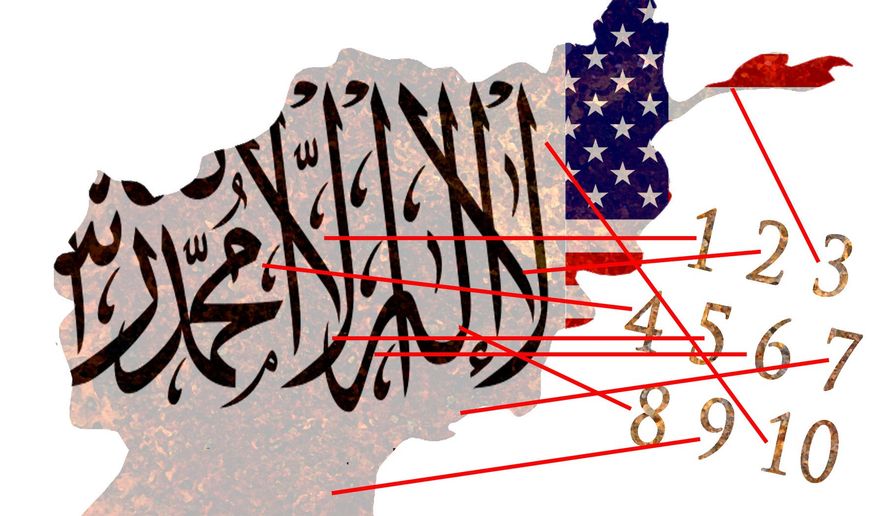Joshua Sinai
The quick and relatively easy takeover by the Taliban of the Afghanistan state, following the precipitous collapse of the government and its security forces, could have been prevented. This would have avoided the current political and humanitarian catastrophe facing the country and its population. This is especially pertinent today during the 20th anniversary of al Qaida’s catastrophic 9/11 attacks, which, like the current precipitous failure of the U.S. intervention in Afghanistan, could have been prevented had the proper counterterrorism campaign measures been in place at the time.
Many lessons have been assembled over the years from previous counterinsurgency campaigns in which a Western country intervened to support a local government and its military forces to counter its threatening terrorism and guerrilla army insurgencies, whether in Vietnam or Somalia, with ten crucial measures of effectiveness standing out that are required to defeat a protracted insurgency.
In the first measure of effectiveness, the intervening government must formulate a political-military campaign plan with clearly defined objectives in realistic timeframes and end-states. It also needs to incorporate an understanding of the underlying causes that drive the insurgency and the necessary solutions to resolve them.
Since late 2001, however, when the U.S. military intervened in Afghanistan to overthrow the Taliban government and defeat and disperse al Qaida’s terrorists, which was initially successful, over the next 20 years, it appeared that each presidential administration would come up with its own ad hoc campaign plan, with the end-states continuously being extended without concrete achievements to resolve the Taliban insurgency. The military intervention by the George W. Bush administration to overthrow Saddam Hussein’s regime in Iraq in March 2003 also served to divert attention from the primary objectives in Afghanistan.
In the second measure of effectiveness, it is crucial for the intervening country to upgrade the local government’s governing capability with a political elite that is committed to effective governance. This is crucial in nation-building as it results in political legitimacy and popular support. Unfortunately, in Afghanistan, any talk about the U.S. supporting ‘nation-building’ was continuously dismissed, with government officials stating that “we do not engage in nation-building.” Many members of the Afghan political elite were also apparently not interested in ‘nation-building’ as they were reported to have used the illicit gains from their corrupt activities to purchase luxury homes in foreign countries if they had to flee Afghanistan.
Third, the local government’s military capability was continuously over-estimated, despite numerous Department of Defense Inspector General-type reports that the Afghan forces were incapable of taking over the American military campaign to fight the Taliban forces on their own – an important measure of effectiveness.
In a fourth measure, the local government’s forces must secure the local population from insurgent attacks. In Afghanistan, the Taliban were always able to attack the local population anywhere, including in Kabul, the country’s capital.
Fifth, in what is known as winning ‘hearts and minds,’ it is crucial for the local government to win the ideological narrative against the insurgent force’s extremist ideas and practices to exponentially increase popular support for the government’s side. However, without attaining its own political legitimacy, the Afghan government never succeeded in winning this narrative battle, despite the Taliban’s extremist and harsh theocratic ideas and practices.
Sixth, winning the ideological narrative also enables the local government to increase the rate of defections from insurgent forces by increasing their disillusionment with the insurgency’s objectives. In Afghanistan, the Taliban’s forces kept replenishing and growing, with some of their ‘supposed’ defectors turning out to be double agent suicide bombers who blew themselves up with their American and Afghanistan intelligence handlers.
Seventh, the intervening foreign power and the local government must gain international and regional support for their counterinsurgency campaign. While most of the world’s nations supported the U.S.-led intervention, the crucial neighboring country of Pakistan kept wavering, with a government’s component continuing to provide covert support to the Taliban, which also enabled it to maintain safe havens in Pakistan’s ungoverned border regions.
Eighth, it is crucial to decrease the insurgent’s funding sources, limiting its capability to fund its managers, operatives, fighters and acquire weapons and ammunition. In Afghanistan, the Taliban’s involvement in narcotrafficking was never seriously challenged – with even government and local warlords’ complicity in narcotrafficking – making it one of the world’s wealthiest insurgent forces and enabling it to pay its managers, operatives, and fighters and acquire new weapons and ammunition for its fighters.
Ninth, it is crucial for the local government’s military forces to exponentially decrease the territory under insurgent control. According to a United Nations Security Council report, in Afghanistan, by June 2021, the Taliban contested or controlled an estimated 50 percent to 70 percent of Afghan territory outside of urban centers.
Finally, if possible, it is crucial to encourage the insurgent’s leadership to moderate their extremist objectives and join a negotiated settlement to the conflict. This was attempted by the Trump and Biden administrations but was never seriously followed up by the Taliban’s leadership.
The twin failures to succeed in achieving these ten measures of effectiveness in counterinsurgency and with the United States government issuing a mid-September 2021 deadline for the withdrawal of its forces from the country, were quickly seized upon by the Taliban, which embarked on a series of military offensives against the demoralized and weakened government forces. The Taliban’s forces quickly grew stronger than their government adversary’s military forces, whom they easily defeated in battle or caused them to desert en masse, thereby easily defeating the government’s forces and taking control of the government in Kabul and the rest of the country.
Hopefully, these lessons in effectiveness in responding against terrorist and guerrilla insurgencies, which unfortunately appear not to have been learned since 9/11, will be learned by government policy-makers to avoid future catastrophes that affect our country’s national security.

No comments:
Post a Comment